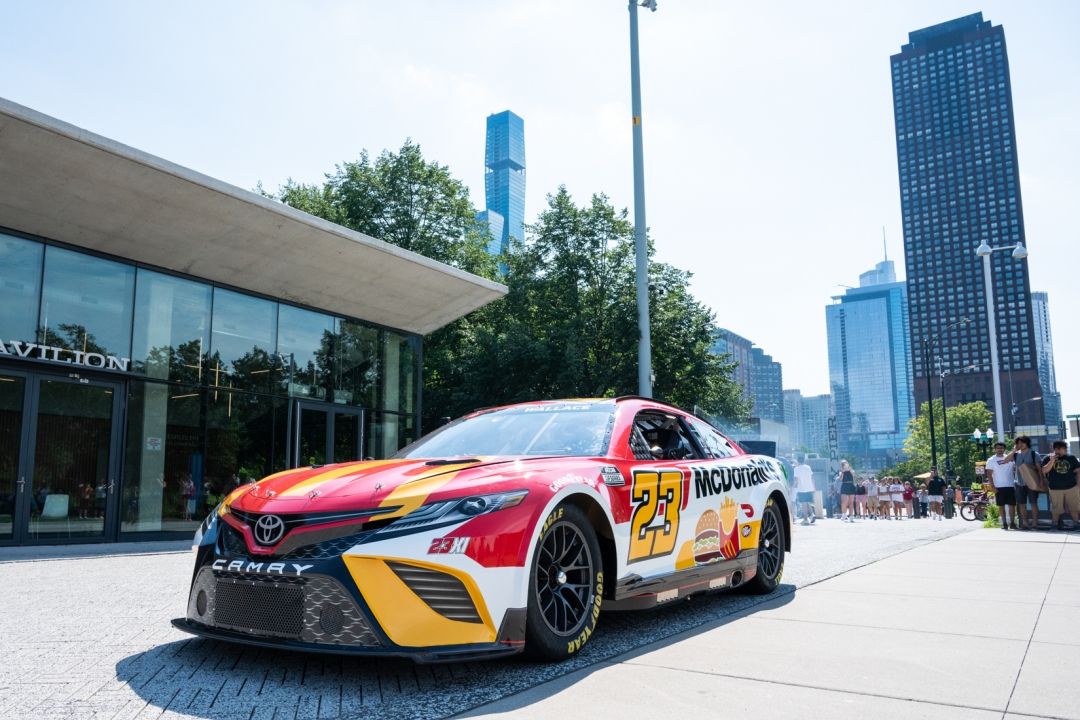NASCAR Zooms In As Chicago Struggles With Dangerous Air Quality. Will Race Make It Worse?
DOWNTOWN — Three days after Chicago’s air was temporarily rated the worst in the world, 40 race cars will take to Downtown streets to race a combined 341 miles around Grant Park.
What does that mean for Chicago’s air quality?
NASCAR racecars are generally unregulated and are not required by the U.S. Environmental Protection Agency to have pollution mitigation devices like catalytic converters, which car emissions less toxic.
Without pollution regulation, the racecars could be “50 to 100 times” more polluting than your average car, according to Brian Urbaszewski, director of environmental health programs at the Respiratory Health Association of Chicago.
Even so, that still may not be enough to worsen local air quality as much as you might think, scientists say.
Standard NASCAR racecars get around five miles per gallon, according to numerous racing publications. If each car completes 341 miles of racing (which NASCAR officials say is unlikely), then nearly 2,800 gallons of fuel will be burned and emitted.
Michael Wang, interim division director for energy systems and infrastructure analysis at Argonne National Laboratory, analyzed those calculations and determined this is the equivalent to the annual emissions of about five cars.
That pollution from a one-off event still doesn’t compare to the emissions from over 1 million cars traveling throughout the city every day, Wang said.
“Yes [NASCAR] has emissions, but it’s a one-time emission … [E]missions from our daily commutes will stay,” Wang said.
Scott Collis, an atmospheric scientist at Argonne, agreed.
“While individual actions matter, the actual impact of a few vehicles on a city of 3 million is relatively small,” Collis said. “By closing down roads and keeping other vehicles away from that area, it’s unlikely to have very bad air quality.”
Credit: Colin Boyle/Block Club Chicago Race cars sit parked during a press event announcing that Chicago will host a first-of-its-kind NASCAR Street Race, on July 19, 2022.
Since 2011, NASCAR’s cars have been using a a corn-based ethanol called Sunoco Green E15. This gasoline blended with 15 percent corn, although still releasing greenhouse gases, has lower emissions than other fuels standardly used by everyday drivers, experts say.
Since switching to E15, NASCAR estimates it has reduced its greenhouse emissions by 20 percent, according to a 2022 news release. The company also has a goal of net-zero emissions by 2035.
“Our own cars use E10. [NASCAR] already moved to E15 so they are ahead of the regular customers like you and I,” Wang said.
NASCAR also plans to install 500 recycling receptacles, 36 hydration stations to refill water bottles and solar-powered light towers at the site, said a NASCAR spokesperson. The company also plans to to work with United Rentals Power to have battery-assisted power instead of having its trailers run on generators throughout the day.
NASCAR will release comprehensive emissions measurements for this weekend’s to monitor the event’s impact, a spokesperson said.
Peter Orris, chief of occupational and environmental medicine at the University of Illinois Hospital, agreed that emissions from the race won’t have much long-term effect.
“They’re only running for one day and the amount of internal combustion automobiles, trucks etc. that we have still have, especially in the Downtown area, contributes a great deal more pollution over an average period of time,” Orris said.
Credit: Provided The NASCAR Chicago course.
What Health Precautions Should NASCAR Fans Take?
While the short-term pollution may not be as severe, fans going to the race should still be aware of the pollutants the cars create, experts said.
Racecars also emit volatile organic compounds, a pollutant that causes ozone formation and smog, which are carcinogens. When fuel burns, it creates nitrogen monoxide and nitrogen dioxide. Heat from the sun then causes these compounds to create smog, scientists said.
Ozone burns lung passages, causes tissue to swell and can make it difficult and uncomfortable to breathe along with triggering asthma attacks, Urbaszewski said.
People in the NASCAR stands with asthma or comorbidities should be cautious because being circled by racecars could likely lead to unhealthy air levels, Orris said. Air pollution can have an acute impact on asthma, chronic lung disease and heart conditions, with a delay of 24 to 48 hours, he said.
“Anything that in general increases [air pollution], is not something from a health point of view that we want to be stimulating. But the balance here is this is not done for that purpose. It’s not done to increase the health of populations, it’s entertainment,” Orris said.
It’s important to check the air quality before heading to the race. The American Lung Association recommends checking the Air Quality Index online. As of Wednesday, the air quality was still deemed “Very Unhealthy,” a category in which people are urged to avoid strenuous outdoor activities and to keep outdoor time short.
Credit: Colin Boyle/Block Club Chicago Construction continues for the upcoming NASCAR Chicago Street Race on June 28, 2023.
The air quality is expected to move to moderate by the weekend. Mimi Guiracocha, manager of health promotions for the American Lung Association, said people should still avoid the outdoors if the air quality is labeled unhealthy.
If the air quality is clear, attendees should still watch for signs of lightheadedness, dizziness and shortness of breath, as air pollution can make breathing more difficult, Guiracocha said.
Attendees also should make sure to take care of their hearing while attending the race event, experts said.
During a NASCAR race, noise levels can range from 95 to 98 decibels – according to Mike Hefferly, an audiologist at RUSH University. A “conservative” estimation from the National Institute of Occupational Safety and Health says an individual should not exceed 30 minutes unprotected at that level of sound.
The best solution is to wear earplugs that are labeled at least 25 dB, Hefferly said. A single pair can run about $1; a pack of 12 from Target is about $5.
“So as long as they’re being used correctly, that’s really what people need. Now you’ll see on TV events where they have these large ear muffs on those can be very effective as well,” Hefferly said.
Any prolonged muffled hearing or ringing in the ears lasting more than 24 hours can indicate hearing damage. At this point an individual should contact their primary health provider.
Attendees can also “prep” their ears beforehand by avoiding loud events and activities leading up to the race, Hefferly said.
Subscribe to Block Club Chicago, an independent, 501(c)(3), journalist-run newsroom. Every dime we make funds reporting from Chicago’s neighborhoods.
Click here to support Block Club with a tax-deductible donation.
Thanks for subscribing to Block Club Chicago, an independent, 501(c)(3), journalist-run newsroom. Every dime we make funds reporting from Chicago’s neighborhoods. Click here to support Block Club with a tax-deductible donation.
Listen to “It’s All Good: A Block Club Chicago Podcast”:
Source: Block Club Chicago


